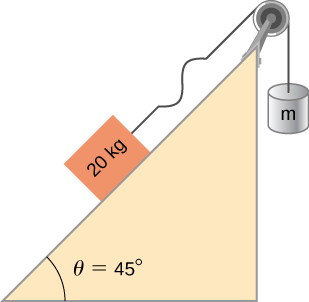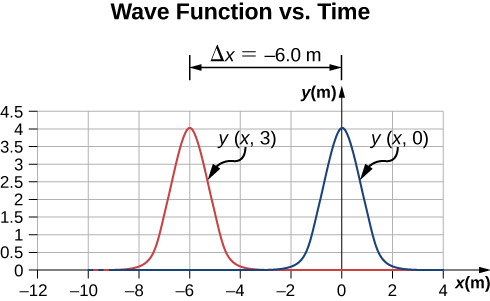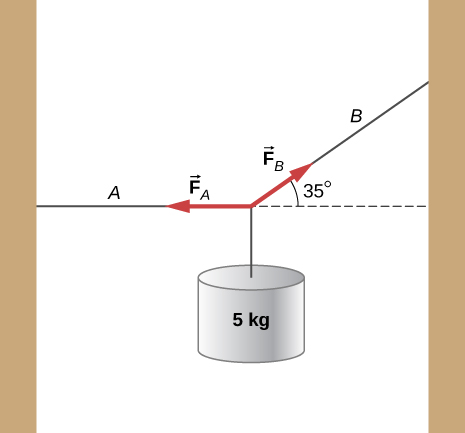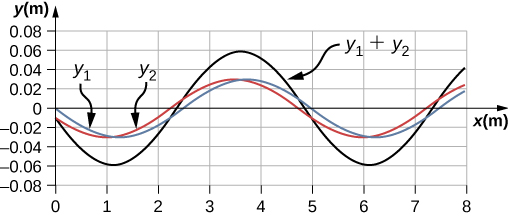| << Chapter < Page | Chapter >> Page > |
A seismograph records the S- and P-waves from an earthquake 20.00 s apart. If they traveled the same path at constant wave speeds of and how far away is the epicenter of the earthquake?
Consider what is shown below. A 20.00-kg mass rests on a frictionless ramp inclined at . A string with a linear mass density of is attached to the 20.00-kg mass. The string passes over a frictionless pulley of negligible mass and is attached to a hanging mass ( m ). The system is in static equilibrium. A wave is induced on the string and travels up the ramp. (a) What is the mass of the hanging mass ( m )? (b) At what wave speed does the wave travel up the string?

a. ; b.
Consider the superposition of three wave functions and What is the height of the resulting wave at position at time
A string has a mass of 150 g and a length of 3.4 m. One end of the string is fixed to a lab stand and the other is attached to a spring with a spring constant of The free end of the spring is attached to another lab pole. The tension in the string is maintained by the spring. The lab poles are separated by a distance that stretches the spring 2.00 cm. The string is plucked and a pulse travels along the string. What is the propagation speed of the pulse?
A standing wave is produced on a string under a tension of 70.0 N by two sinusoidal transverse waves that are identical, but moving in opposite directions. The string is fixed at and Nodes appear at 2.00 m, 4.00 m, 6.00 m, 8.00 m, and 10.00 m. The amplitude of the standing wave is 3.00 cm. It takes 0.10 s for the antinodes to make one complete oscillation. (a) What are the wave functions of the two sine waves that produce the standing wave? (b) What are the maximum velocity and acceleration of the string, perpendicular to the direction of motion of the transverse waves, at the antinodes?
A string with a length of 4 m is held under a constant tension. The string has a linear mass density of Two resonant frequencies of the string are 400 Hz and 480 Hz. There are no resonant frequencies between the two frequencies. (a) What are the wavelengths of the two resonant modes? (b) What is the tension in the string?
a. ; b.
A copper wire has a radius of and a length of 5.0 m. The wire is placed under a tension of 3000 N and the wire stretches by a small amount. The wire is plucked and a pulse travels down the wire. What is the propagation speed of the pulse? (Assume the temperature does not change:
A pulse moving along the x axis can be modeled as the wave function (a)What are the direction and propagation speed of the pulse? (b) How far has the wave moved in 3.00 s? (c) Plot the pulse using a spreadsheet at time and to verify your answer in part (b).
a. Moves in the negative
x direction at a propagation speed of
. b.
c.

A string with a linear mass density of is fixed at both ends. A 5.0-kg mass is hung from the string, as shown below. If a pulse is sent along section A , what is the wave speed in section A and the wave speed in section B ?

Consider two wave functions and . What is the wave function resulting from the interference of the two wave? ( Hint: and .)
The wave function that models a standing wave is given as . What are two wave functions that interfere to form this wave function? Plot the two wave functions and the sum of the sum of the two wave functions at to verify your answer.
Consider two wave functions and . The resultant wave form when you add the two functions is Consider the case where , and . (a) Where are the first three nodes of the standing wave function starting at zero and moving in the positive x direction? (b) Using a spreadsheet, plot the two wave functions and the resulting function at time to verify your answer.
;


Notification Switch
Would you like to follow the 'University physics volume 1' conversation and receive update notifications?